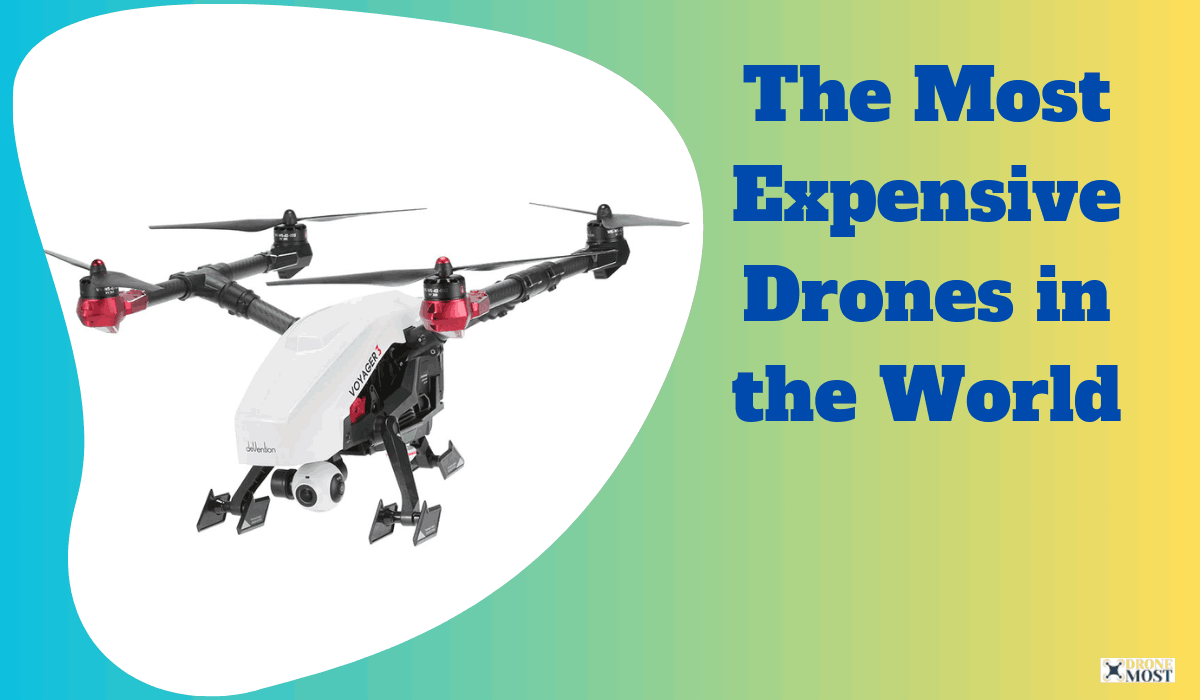Contents
- Definition of expensive drones
- List of Most Expensive Drones in 2023
- Freefly Systems Alta X (most expensive in the world- $18,200)
- Key Features:
- Specifications:
- DJI Matrice 600 Pro (most expensive in the world- $6,999.95)
- Key Features:
- Specifications:
- Walkera Voyager 3 (most expensive in the world- $1838)
- Key Features:
- Specifications:
- Xactsense Titan (most expensive in the world- $120,000)
- Key Features:
- Specifications:
- EHang 184 (most expensive Commercial Drone in the world- $300,000)
- Key Features:
- Specifications:
- Airborne Drones Vanguard (most expensive in the world- $45,000)
- Key Features:
- Specifications:
- Xactsense Max-8 (most expensive in the world- $19,495.99)
- Key Features:
- Specifications:
- Lockheed Martin Indago (most expensive in the world- $25000)
- Key Features:
- Specifications:
- MULTIROTOR G4 Eagle V2 (most expensive in the world- $28,260)
- Key Features:
- Specifications:
- MULTIROTOR G4 Surveying Robot (most expensive in the world- $25,420)
- Key Features:
- Specifications:
- Scorpion 3 Hoverbike (the most expensive drone in the world- $150,000)
- Key Features:
- Specifications:
- AEE F100 (the most expensive drone in the world- $58,000)
- Key Features:
- Specifications:
- Buying Considerations for the Most Expensive Drones in the World
- FAQs (Frequently Asked Questions)
- Why are the most expensive drones so costly?
- Are these drones legal to fly everywhere?
- Can beginners handle the complexity of high-end drones?
- Do these drones require special maintenance?
- What kind of skills are necessary to operate high-end drones?
- Conclusion
Definition of expensive drones
The Most Expensive Drones in the World: represent the pinnacle of technological achievement in unmanned aerial systems, embodying cutting-edge features and capabilities that transcend conventional drone capabilities. The term “expensive” in this context goes beyond mere cost; it encapsulates a spectrum of advanced functionalities and state-of-the-art engineering that elevate these drones to the zenith of the UAV market.
These high-end drones redefine industry standards, boasting unmatched precision, durability, and versatility. Equipped with sophisticated imaging systems, such as advanced cameras and sensors, they cater to diverse sectors like cinematography, industrial inspections, and military reconnaissance.
Their significance lies not only in their elevated price point but in the transformative impact they bring to specialized fields. Expensive drones often incorporate superior materials, intricate designs, and proprietary technologies that enhance performance and operational efficiency.
These unmanned systems become invaluable assets in sectors where precision and reliability are paramount. In essence, the term “expensive drones” transcends monetary value, encapsulating a realm of innovation that pushes the boundaries of what unmanned aerial vehicles can achieve, thereby shaping the trajectory of aerial technology in the modern era.
List of Most Expensive Drones in 2023
Curating a list of the most expensive drones in 2023 unveils a roster of technological marvels that represent the epitome of aerial innovation. These drones are not just tools; they are statements of excellence, each with its unique set of features and capabilities.
Freefly Systems Alta X (most expensive in the world- $18,200)
The Freefly Systems Alta X, standing as the most expensive drone globally at $18,200, epitomizes the zenith of aerial technology. This high-flying marvel is not merely a drone; it’s an airborne powerhouse designed for professional cinematography.
Boasting an impressive payload capacity and exceptional stability, the Alta X caters to filmmakers and content creators who demand unparalleled precision in capturing breathtaking aerial shots.
Its cutting-edge features include a versatile payload mounting system, robust carbon fibre construction, and advanced flight control systems. Pioneering the skies with innovation, the Alta X redefines what’s possible in aerial cinematography, making it a top choice for those who seek uncompromising quality and performance in the world of drones.
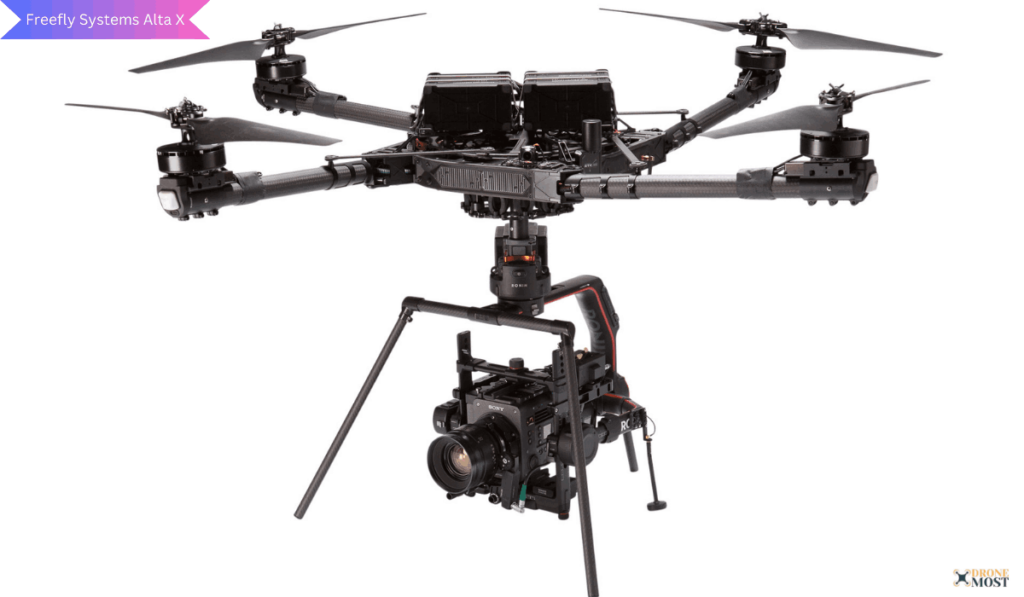
Key Features:
- Octocopter Design: Eight powerful motors provide exceptional stability, agility, and payload capacity.
- Modular Design: Easily adaptable to various payloads and accessories for diverse applications.
- Heavy-Lift Capabilities: Carries up to 35 pounds (15.9 kg) of payload, ideal for large cameras, LiDAR systems, or other equipment.
- Long Flight Time: Up to 35 minutes of flight time with dual batteries, enabling extended missions.
- CineStar 8 Motor System: Sinusoidal motor drives for smoother, quieter flight and more precise control.
- SyncPilot App: Streamlined control and mission planning through a user-friendly mobile app.
- Open Source Compatibility: Works with open-source autopilot systems like ArduPilot for flexibility and customization.
Specifications:
- Diagonal Wheelbase: 55 inches (1397 mm)
- Maximum Takeoff Weight: 75 pounds (34 kg)
- Maximum Payload: 35 pounds (15.9 kg)
- Maximum Flight Time: 35 minutes
- Maximum Transmission Range: 10 miles (16 km) with optional radios
- Flight Controller: Open-source compatible (e.g., ArduPilot)
- Video Transmission System: Optional (e.g., Freefly Wave, third-party systems)
- Battery: Dual 5400 mAh 6S LiPo batteries
Pros:
- Exceptional payload capacity and flight time for demanding applications.
- Highly customizable and adaptable to various payloads and missions.
- Smooth, quiet flight performance for professional-quality aerial footage.
- Open-source compatibility for flexibility and integration with custom systems.
- Reliable and well-regarded brand within the professional drone industry.
Cons:
- High price point, primarily for professional use cases.
- Setup and operation require a higher level of technical expertise.
- Large size and weight can make transportation and setup more challenging.
- Requires additional components for video transmission and advanced features.
- Potential availability and support limitations compared to larger manufacturers.
DJI Matrice 600 Pro (most expensive in the world- $6,999.95)
The DJI Matrice 600 Pro, priced at $6,999.95, stands as a beacon of excellence in the drone world. Renowned for its versatility, this high-end UAV caters to professional cinematographers and aerial photographers.
With an advanced flight control system and a robust frame, the Matrice 600 Pro ensures stability and reliability in capturing stunning aerial visuals. Its compatibility with various Zenmuse cameras and gimbals expands its creative potential.
Whether for film, broadcasting, or industrial applications, the Matrice 600 Pro exemplifies DJI’s commitment to delivering cutting-edge technology, making it a premium choice for those seeking top-tier drone capabilities.

Key Features:
- Heavy-lift capability: Can carry up to 6 kg (13.2 lb) of payload, making it ideal for a wide range of professional applications.
- Modular design: Easily adaptable to different tasks with a wide selection of compatible cameras, gimbals, and other accessories.
- Six-rotor configuration: Provides exceptional stability and redundancy for reliable flight performance.
- Advanced flight controller: Features intelligent flight modes, obstacle avoidance, and real-time data transmission for enhanced safety and control.
- Long flight time: Up to 38 minutes of flight time with dual battery configuration.
- Extensive range: Up to 5 km (3.1 miles) with the included Lightbridge 2 transmission system.
Specifications:
- Dimensions: 1668 x 1518 x 727 mm (65.7 x 59.8 x 28.6 in)
- Weight: 9.5 kg (20.9 lb) without payload
- Max takeoff weight: 15.5 kg (34.2 lb)
- Max payload: 6 kg (13.2 lb)
- Max flight time: 38 minutes
- Max speed: 64 km/h (40 mph)
- Max service ceiling: 2500 m (8200 ft)
- Max wind resistance: 12 m/s (27 mph)
- Transmission system: Lightbridge 2
- Remote controller: Cendence
- Camera compatibility: Zenmuse X5S, X5R, XT, Z30, and other third-party cameras
Pros:
- A powerful and stable platform for professional applications.
- Modular design for flexibility and customization.
- Long flight time for extended missions.
- Reliable transmission system for clear and stable video.
- Intelligent flight modes for ease of operation.
- Openness to third-party software and hardware.
Cons:
- High price point, suitable for professional uses.
- Complex setup and operation compared to consumer drones.
- Large size and weight may be difficult to transport.
- Limited availability of compatible payloads and software.
- Discontinued model (as of December 2023), newer models might offer better options.
Walkera Voyager 3 (most expensive in the world- $1838)
The Walkera Voyager 3, priced at $1838, exemplifies sophistication in the world of drones. Renowned for its prowess in industrial inspections and surveillance, this UAV combines cutting-edge technology with a user-friendly design.
With a 360-degree rotating gimbal and a 16x optical zoom camera, the Voyager 3 offers unparalleled versatility for capturing high-quality images and videos. Its intelligent flight modes and obstacle avoidance features enhance operational safety and efficiency.
Whether navigating complex environments or conducting precise inspections, the Walkera Voyager 3 is invaluable. In the realm of expensive drones, it strikes a balance between advanced functionality and accessibility, making it a preferred choice for professionals across various industries.
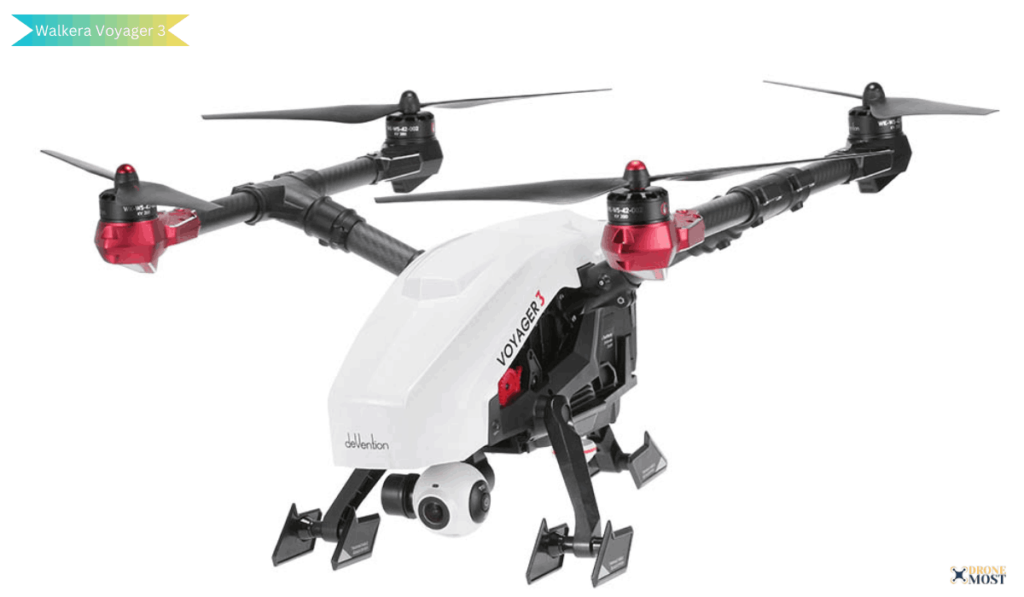
Key Features:
- 4K UHD Camera: Capture stunning visuals with a 1/2.8-inch CMOS sensor that shoots 4K UHD video at 30 fps and captures 12MP still images. This resolution delivers crisp details and vivid colours, perfect for showcasing your adventures.
- 3-Axis Gimbal Stabilization: Enjoy smooth and stabilized footage thanks to the integrated 3-axis gimbal. This technology compensates for camera shake and vibrations, ensuring cinematic-quality shots even in windy conditions.
- GPS and Smart Flight Modes: Navigate with confidence and ease using the built-in GPS. The Voyager 3 also offers smart flight modes like Waypoint Flight, Return to Home, and Follow Me, allowing you to focus on capturing stunning visuals while the drone handles the piloting.
- Long Flight Time: Explore a long-range drone with a flight time of up to 25 minutes, thanks to the efficient battery management system. This lets you cover more ground and capture more breathtaking aerial footage.
- Foldable Design and Compact Size: Take your drone adventures anywhere with the Voyager 3’s foldable design. It easily fits into your backpack, making it ideal for travel and outdoor activities.
Specifications:
- Camera: 1/2.8-inch CMOS sensor, 4K UHD video at 30 fps, 12MP still images.
- Gimbal: 3-axis
- Flight Time: Up to 25 minutes
- Control Range: Up to 500 meters (1,640 ft)
- Max Flight Speed: 40 km/h (25 mph)
- Battery Capacity: 7.6V 3000mAh Li-ion
- Dimensions: Unfolded: 292 x 248 x 73mm (11.5 x 9.8 x 2.9 in) Folded: 170 x 147 x 73mm (6.7 x 5.8 x 2.9 in)
- Weight: 530g (1.17 lb)
Pros:
- Impressive range and flight time for exploring vast distances and capturing expansive views.
- Efficient and stable flight thanks to the fixed-wing design.
- Portable and convenient for transportation and travel.
- Versatile flight modes cater to different skill levels and needs.
- Real-time telemetry for informed flight control.
Cons:
- Requires initial assembly and setup before each flight.
- Ground station transmitter setup can be complex for beginners.
- Manual control requires pilot experience with fixed-wing aircraft.
- Limited video transmission capabilities compared to drones with dedicated cameras.
- Higher price tag compared to some multi-rotor drones.
Xactsense Titan (most expensive in the world- $120,000)
The Xactsense Titan, priced at a pinnacle of $120,000, epitomizes the zenith of drone technology. Far beyond a mere aerial device, this drone stands as a testament to cutting-edge engineering and unparalleled capabilities.
Tailored for specialized applications, Titan’s price tag reflects a commitment to excellence in fields like mapping and surveying. With state-of-the-art sensors and precision instruments, it delivers unrivalled accuracy in geospatial analysis.
Its robust design and advanced flight control systems ensure reliability in the most demanding environments. In the ever-evolving landscape of expensive drones, the Xactsense Titan not only commands attention with its price but also with a promise to redefine the standards of performance and precision in the realm of unmanned aerial vehicles.
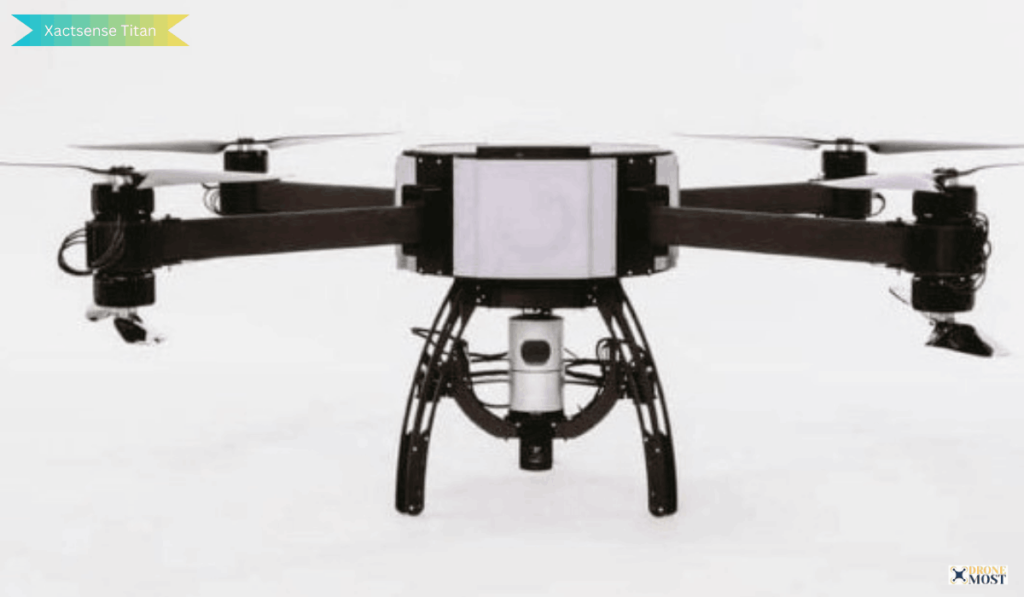
Key Features:
- Hybrid Design: Combines the vertical takeoff and landing (VTOL) capabilities of a multi-copter with the long-range and endurance of a fixed-wing aircraft.
- Long Range and Endurance: Up to 75 miles (120 km) range and 3 hours of flight time, enabling extensive data collection over large areas.
- High Payload Capacity: Carries up to 5 pounds (2.3 kg) of payload, suitable for various sensors and equipment.
- Rugged Construction: Designed for harsh environments and inclement weather, with a waterproof rating and durable materials.
- Advanced Autonomy: Capable of autonomous flight and mission planning, reducing operator workload and increasing efficiency.
- Open-Source Compatibility: Works with open-source autopilot systems like ArduPilot for flexibility and customization.
Specifications:
- Wingspan: 8 feet (2.4 meters)
- Length: 4 feet (1.2 meters)
- Maximum Takeoff Weight: 25 pounds (11.3 kg)
- Maximum Payload: 5 pounds (2.3 kg)
- Maximum Flight Time: 3 hours
- Maximum Range: 75 miles (120 km)
- Flight Controller: Open-source compatible (e.g., ArduPilot)
- Video Transmission System: Optional (e.g., XactSense Clarity)
- Battery: 6S LiPo battery
Pros:
- Long range and endurance for extended missions.
- High payload capacity for a variety of sensors and equipment.
- Rugged design for challenging environments and weather conditions.
- Advanced autonomy features for efficient operation.
- Open-source compatibility for flexibility and customization.
Cons:
- High price point, primarily for professional use cases.
- Complex setup and operation require technical expertise.
- Limited availability and support compared to larger manufacturers.
- Potential regulatory restrictions for hybrid VTOL drones in certain regions.
EHang 184 (most expensive Commercial Drone in the world- $300,000)
The EHang 184, commanding a staggering $300,000 price tag, redefines the landscape of commercial drones. More than just an aerial vehicle, it’s a paradigm shift in urban air mobility.
This cutting-edge drone stands as a testament to innovation, designed for personal transportation in urban environments. With its autonomous flying capabilities and sleek design, the EHang 184 represents the future of air travel.
While its cost may seem substantial, it reflects the pioneering technology embedded in this aerial vehicle, making it a revolutionary investment in the evolution of urban transportation, where the skies become highways and drones become personal air taxis.

Key Features:
- Autonomous Flight: Designed to fly passengers without a human pilot, navigating through pre-programmed routes and air traffic control systems.
- Electric Power: Uses 16 electric motors and propellers for quiet and efficient flight, reducing noise pollution and emissions.
- Single-Passenger Capacity: Carries one passenger with a maximum weight of 100 kg (220 lb) in a comfortable enclosed cockpit.
- Vertical Takeoff and Landing (VTOL): Capable of taking off and landing vertically, eliminating the need for runways and expanding potential landing sites.
- Flight Range and Speed: Ranges up to 35 km (22 miles) with a flight time of approximately 25 minutes at a cruising speed of 130 km/h (81 mph).
- Redundant Safety Systems: Built with multiple backup systems for power, control, and navigation to ensure safe flight operations.
Specifications:
- Dimensions: 5.61 x 4.39 x 1.46 meters (18.4 x 14.4 x 4.8 feet)
- Weight: 200 kg (441 lb) with 100 kg (220 lb) payload capacity
- Max takeoff weight: 300 kg (661 lb)
- Max flight time: 25 minutes
- Max speed: 130 km/h (81 mph)
- Max service ceiling: 3500 meters (11500 feet)
- Power source: Electric batteries
- Flight control system: Autonomous with ground monitoring
Pros:
- Potential for urban air mobility, reducing traffic congestion and commute times.
- Zero-emissions flight for environmental benefits.
- Increased accessibility for individuals with disabilities or those who cannot operate traditional vehicles.
- Reduced risk of human error due to autonomous operation.
Cons:
- Not yet certified for commercial use in most countries, facing regulatory hurdles.
- Public acceptance and safety concerns regarding autonomous passenger flight.
- Limited range and flight time compared to traditional aircraft.
- Potential vulnerability to hacking and cyberattacks.
- High cost of development and infrastructure.
Airborne Drones Vanguard (most expensive in the world- $45,000)
The Airborne Drones Vanguard crowned as the most expensive drone globally at $45,000, stands as a symbol of aerial prowess and innovation. Beyond a mere UAV, it’s a precision tool tailored for agricultural applications.
With state-of-the-art sensors and imaging technology, the Vanguard transforms farming practices, enabling precision agriculture and crop management. Its robust design and advanced flight systems ensure reliability in the dynamic field of agriculture.
While the price tag may seem substantial, it mirrors the investment in cutting-edge technologies that elevate the Airborne Drones Vanguard to a position of prominence, shaping the future of precision farming and marking a milestone in the evolution of agricultural drone applications.
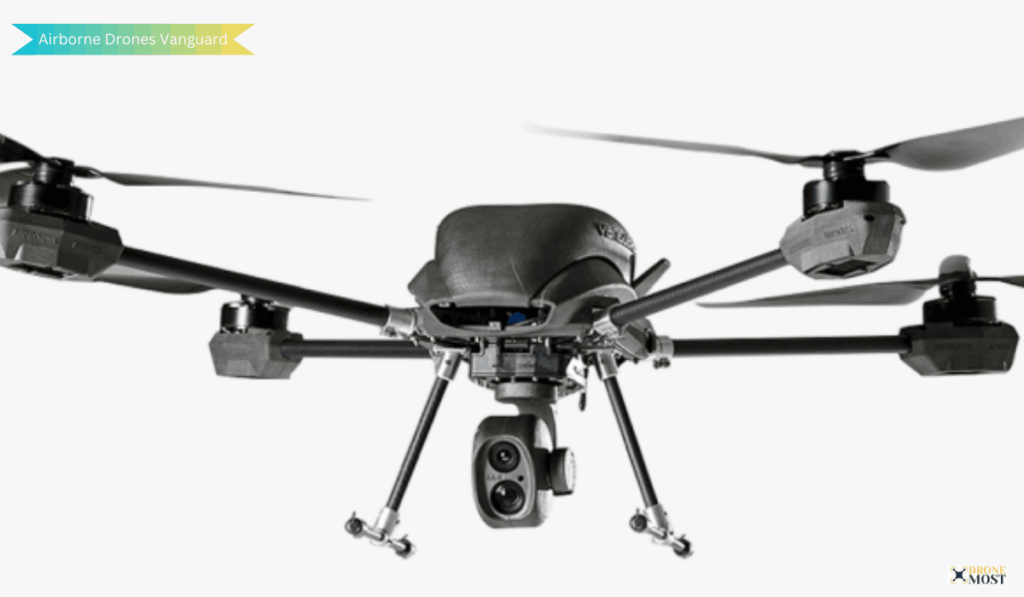
Key Features:
- Long-range and endurance: Up to 3.5 hours of flight time and a range of 120 miles (193 km) on a single battery charge, ideal for covering large areas.
- High-resolution imagery: Equipped with a Sony RX1R II 42MP full-frame mirrorless camera for capturing stunning detailed images and video.
- LiDAR mapping: Optional LiDAR payload enables accurate elevation data collection for creating 3D maps and models.
- Advanced autopilot: Auterion autopilot system provides precise flight control and autonomous mission planning capabilities.
- Rugged construction: Designed for harsh weather conditions with water-resistant electronics and a durable airframe.
Specifications:
- Wingspan: 8.2 ft (2.5 m)
- Length: 5.9 ft (1.8 m)
- Maximum takeoff weight: 13.2 lbs (6 kg)
- Payload capacity: 4.4 lbs (2 kg)
- Flight time: Up to 3.5 hours
- Range: Up to 120 miles (193 km)
- Camera: Sony RX1R II 42MP full-frame mirrorless
- LiDAR: Optional (various configurations available)
- Autopilot: Auterion
Pros:
- Excellent long-range and endurance capabilities for covering large areas.
- High-resolution imagery and optional LiDAR for detailed data collection.
- Advanced autopilot and autonomous mission planning features for ease of operation.
- Rugged construction for use in a variety of weather conditions.
Cons:
- High price point, primarily for professional use cases.
- Larger size and weight compared to some multi-motor drones, requiring more space for take-off and landing.
- Requires more technical expertise to operate compared to beginner-friendly drones.
- Limited availability of support and spare parts compared to larger manufacturers.
Xactsense Max-8 (most expensive in the world- $19,495.99)
The Xactsense Max-8, priced at $19,495.99, stands as a beacon of technological excellence in the world of drones. This high-end UAV is more than just an aerial device; it’s a precision instrument designed for research and environmental monitoring. With state-of-the-art sensors and cutting-edge data collection capabilities, the Max-8 elevates scientific research to new heights.
Its robust construction and advanced flight controls ensure reliability in diverse environmental conditions. While the cost may seem significant, it mirrors the investment in groundbreaking technologies that empower researchers and environmentalists, making the Xactsense Max-8 a valuable asset in the pursuit of knowledge and the preservation of our planet.
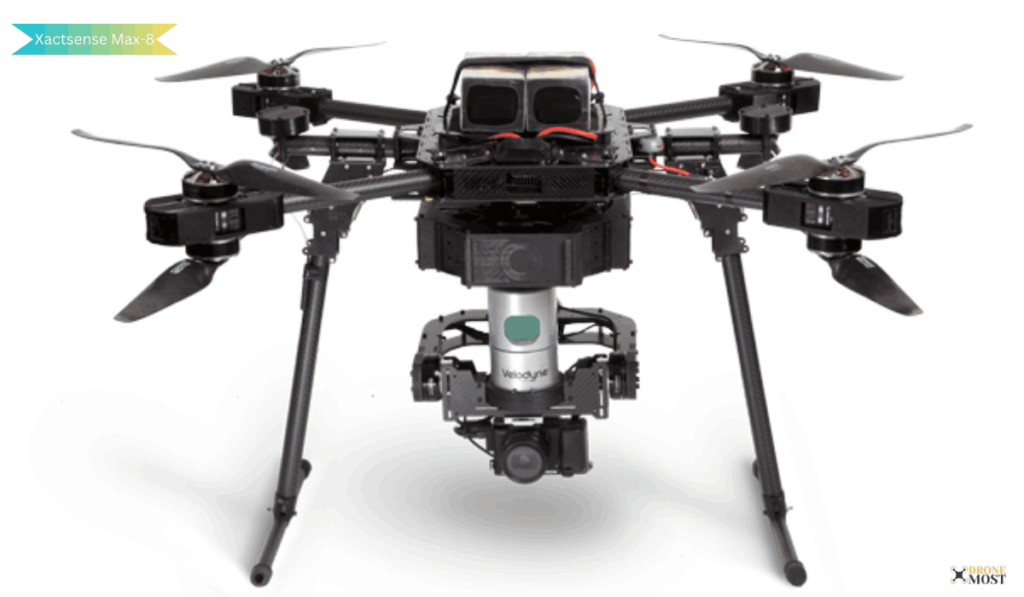
Key Features:
- Industry-Focused Design: Built for demanding industrial applications, including inspection, mapping, surveying, and surveillance.
- Heavy-Lift Capabilities: Can carry up to 8.5 kg (18.7 lb) of payload, making it ideal for transporting various sensors and equipment.
- Extended Flight Time: Offers a flight time of up to 60 minutes, allowing for extended missions and comprehensive data collection.
- Modular Design: Easily adaptable to different tasks with a wide range of compatible sensors and payload options.
- Rugged Construction: Built to withstand harsh environments and inclement weather conditions, ensuring reliability in challenging fields.
- Advanced Flight Features: Includes GPS-based navigation, autonomous flight modes, obstacle avoidance, and return-to-home functionality for enhanced safety and precision.
- Data Capture and Analysis: Seamlessly integrates with XactSense software for comprehensive data processing, analysis, and reporting.
Specifications:
- Dimensions: 1000 x 1000 x 550 mm (39.4 x 39.4 x 21.7 in)
- Weight: 9.5 kg (20.9 lb) without payload
- Max takeoff weight: 18 kg (39.7 lb)
- Max payload: 8.5 kg (18.7 lb)
- Max flight time: 60 minutes
- Max speed: 72 km/h (44.7 mph)
- Max wind resistance: 15 m/s (33.5 mph)
- Transmission system: Long-range radio link
- Remote controller: Ground control station
- Camera compatibility: Wide range of sensors, cameras, and LiDAR systems
Pros:
- High payload capacity for a variety of sensors and equipment.
- Long flight time for extended missions and data collection.
- Rugged construction for use in challenging environments.
- Advanced autonomy features for efficient operation.
- Modular design for flexibility and customization.
- Open-source compatibility for tailored solutions.
Cons:
- High price point, primarily for professional use cases.
- Complex setup and operation require technical expertise.
- Limited availability and support compared to larger manufacturers.
- Potential regulatory restrictions for octocopter drones in certain regions.
Lockheed Martin Indago (most expensive in the world- $25000)
The Lockheed Martin Indago, priced at $25,000, stands at the forefront of military-grade drone technology. More than just an unmanned aerial vehicle, it’s a strategic asset, redefining the landscape of reconnaissance and defence.
Compact yet powerful, the Indago boasts advanced sensors and a robust design, ensuring reliability in the most critical situations. While its cost may appear substantial, It reflects the investment in cutting-edge capabilities that empower military forces with unmatched intelligence and surveillance, marking the Indigo as a pinnacle in the evolution of drones for defence applications.
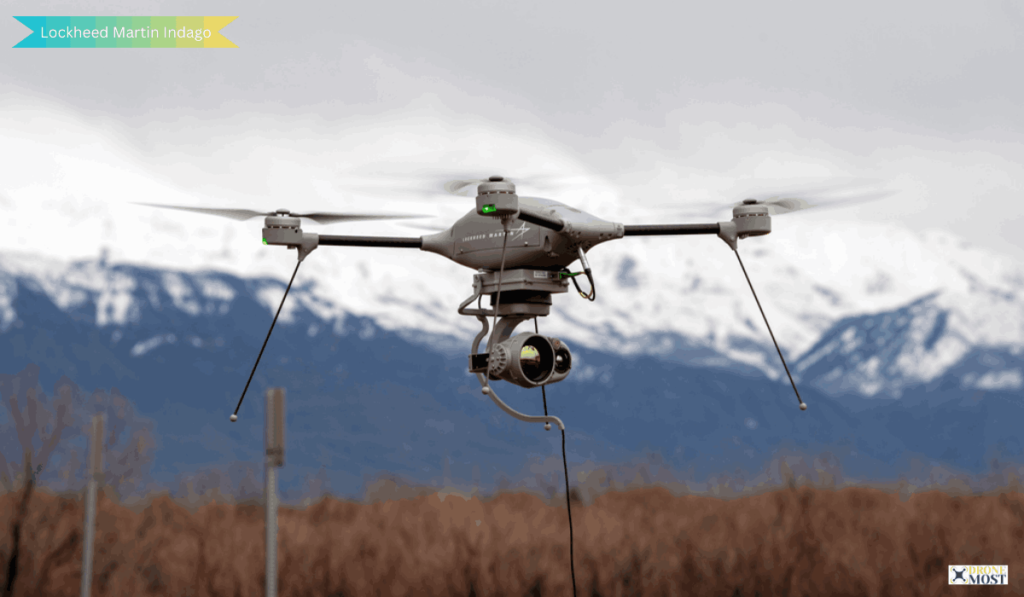
Key Features:
- Compact and portable: Designed for easy deployment and transport, with a wingspan of just 6.6 feet (2 meters) and a weight of under 10 pounds (4.5 kg).
- Long endurance: Capable of flying for up to 6 hours, ideal for extended surveillance missions.
- High-resolution imagery: Equipped with electro-optical and infrared (EO/IR) cameras for capturing detailed images and video in both day and night conditions.
- Automatic takeoff and landing (ATOL): Can launch and land autonomously without needing a runway, making it suitable for operation in remote or austere environments.
- Real-time data transmission: Sends live video and sensor data back to the operator in real-time for enhanced situational awareness.
- Encrypted communications: Uses secure communication channels to protect data from interception.
Specifications:
- Wingspan: 6.6 ft (2 m)
- Length: 4.3 ft (1.3 m)
- Maximum takeoff weight: 9.9 lbs (4.5 kg)
- Payload capacity: 3.3 lbs (1.5 kg)
- Flight time: Up to 6 hours
- Range: Up to 15 miles (24 km)
- Engine: Electric
- Camera: EO/IR (various configurations available)
- Launch method: ATOL
Pros:
- Exceptional portability and ease of deployment.
- Long endurance for extended surveillance missions.
- High-resolution imagery for detailed reconnaissance.
- Autonomous operation capabilities for efficient deployment.
- Real-time data transmission for enhanced situational awareness.
- Secure communication channels for data protection.
Cons:
- High price point, primarily for military and government use.
- Limited availability to the public.
- Complex operations and maintenance require specialized training.
- Export restrictions may apply depending on the destination country.
MULTIROTOR G4 Eagle V2 (most expensive in the world- $28,260)
The MULTIROTOR G4 Eagle V2, priced at $28,260, is not just a drone; it’s a pinnacle of technological excellence in land surveying. This high-end UAV combines precision and efficiency to redefine the standards of mapping and geospatial analysis.
Equipped with state-of-the-art sensors and surveying instruments, the Eagle V2 provides unparalleled accuracy in land surveying applications. Its robust design and advanced flight control systems ensure reliability even in challenging terrains.
While the cost may seem substantial, it mirrors the investment in cutting-edge technology that streamlines surveying processes. The MULTIROTOR G4 Eagle V2, with its elevated capabilities, becomes an indispensable tool for professionals in the field, marking a significant advancement in the realm of surveying drones.
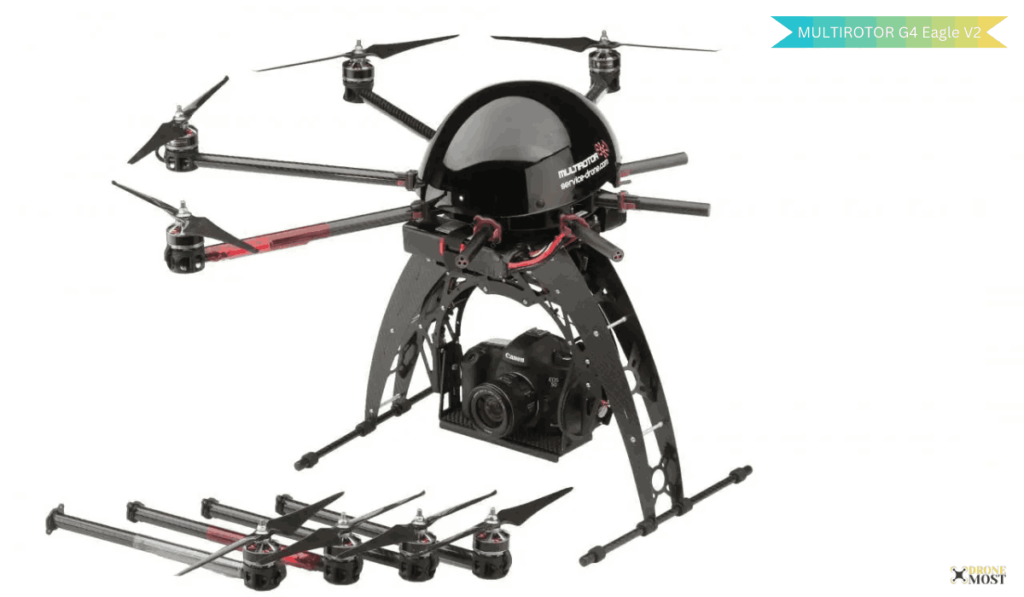
Key Features:
- High Payload Capacity: Carries up to 13.2 lbs (6 kg) of payload, allowing for versatile use with various camera systems, LiDAR sensors, and other equipment.
- Long Flight Time: Up to 60 minutes of flight time with dual 6S LiPo batteries, enabling extended missions and data collection.
- Rugged Construction: Built for harsh environments with a carbon fibre frame, weather-resistant design, and quick-release folding arms for portability.
- Advanced Autonomy: Capable of autonomous flight and mission planning, including waypoint navigation, geo-fencing, and return-to-home functionality.
- Dual Video Transmission Systems: Redundant 2.4GHz and 5.8GHz transmission systems ensure reliable video and data links.
- Open-Source Compatibility: Works with open-source autopilot systems like Ardupilot for flexibility and customization.
Specifications:
- Diagonal Wheelbase: 23.6 inches (60 cm)
- Maximum Takeoff Weight: 33.1 lbs (15 kg)
- Maximum Payload: 13.2 lbs (6 kg)
- Maximum Flight Time: 60 minutes
- Maximum Range: 5 miles (8 km) with optional long-range antenna
- Flight Controller: Open-source compatible (e.g., ArduPilot)
- Video Transmission System: Dual 2.4GHz and 5.8GHz
- Battery: Dual 6S LiPo batteries
Pros:
- Impressive payload capacity for heavy cameras, LiDAR systems, and other sensors.
- Long flight time for extended data collection and missions.
- Rugged design withstands demanding environments and weather conditions.
- Advanced autonomy features for automated flight and reduced operator workload.
- Dual video transmission systems for reliable video and data links.
- Open-source compatibility allows for customization and integration with additional software.
Cons:
- High price point, primarily for professional use cases.
- Larger size and weight compared to some drones, requiring more space for takeoff and landing.
- Requires technical expertise for setup, operation, and maintenance.
- Limited availability and support compared to larger drone manufacturers.
MULTIROTOR G4 Surveying Robot (most expensive in the world- $25,420)
The MULTIROTOR G4 Surveying Robot, valued at $25,420, represents the epitome of precision and efficiency in land surveying. Going beyond the conventional concept of a drone, this high-end UAV stands as a sophisticated surveying instrument.
Equipped with cutting-edge sensors and state-of-the-art technology, the G4 Surveying Robot ensures unparalleled accuracy in mapping and surveying applications. Its robust construction and advanced flight controls enable seamless operation even in challenging terrains.
While the price may seem substantial, it mirrors the investment in advanced surveying capabilities, making the MULTIROTOR G4 Surveying Robot an essential tool for professionals seeking uncompromising accuracy and efficiency in land surveying.
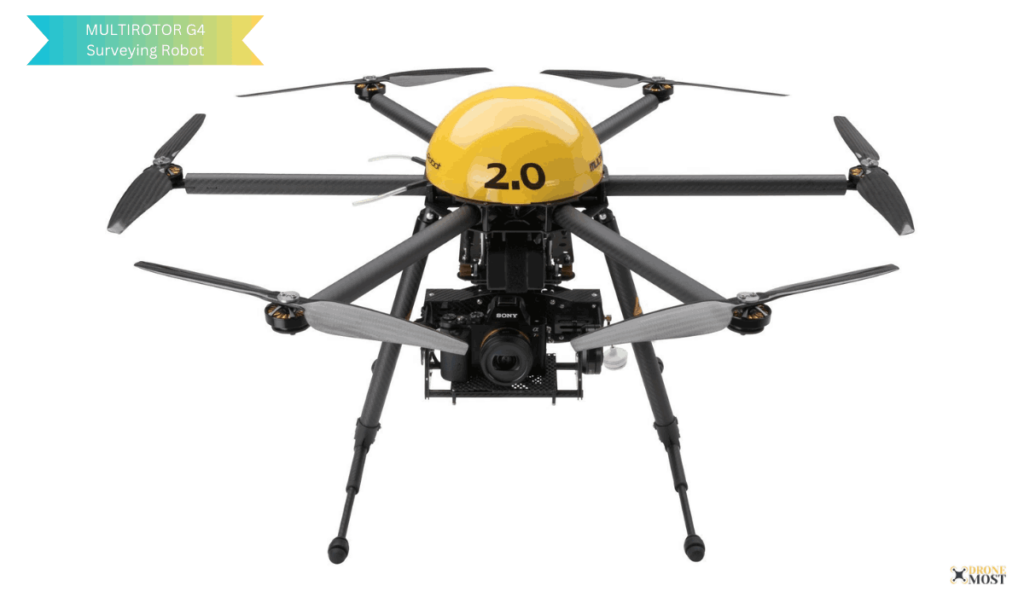
Key Features:
- High-Precision LiDAR System: Equipped with a LiDAR system for generating detailed 3D point clouds with centimetre-level accuracy, ideal for topographic surveys, volumetric, and asset inspections.
- Long Flight Time: Up to 60 minutes in the air, covering more ground and reducing the need for frequent battery changes, improving your survey efficiency.
- Autonomous Flight: Pre-programmed flight paths and obstacle avoidance technology enable autonomous missions, minimizing manual operation and human error.
- Rugged Construction: Built for harsh environments with weather resistance and a durable carbon fibre frame, ensuring reliable operation in challenging conditions.
- Versatile Payload Options: Compatible with various sensors and equipment like multispectral cameras and thermal imaging systems for diverse surveying applications.
- Data Capture and Processing Software: Integrated software seamlessly records and processes LiDAR data, generating accurate 2D and 3D deliverables for immediate insights.
Specifications:
- Dimensions: Unfolded: 1620 x 1620 x 700mm (63.8 x 63.8 x 27.6in) Folded: 1000 x 800 x 700mm (39.4 x 31.5 x 27.6in)
- Weight: 12 kg (26.5 lbs)
- Max takeoff weight: 22 kg (48.5 lbs)
- Max payload: 10 kg (22 lbs)
- Max flight time: 60 minutes
- Max speed: 72 km/h (44.7 mph)
- Max wind resistance: 12 m/s (27 mph)
- Transmission system: Long-range radio link
- Remote controller: Ground control station
- Payload compatibility: LiDAR systems, multispectral cameras, thermal imaging, and more
Pros:
- Increased surveying efficiency and coverage compared to traditional methods.
- Access to difficult-to-reach terrain and complex environments.
- Autonomous operation reduces operator workload and improves safety.
- High-quality LiDAR and image data for detailed 3D models and maps.
- Customizable and adaptable to various surveying needs.
Cons:
- High cost, likely even higher than the G4 Eagle V2 due to additional robotics components.
- Complex operation and maintenance, requiring expertise in both drone and robotics technologies.
- Limited availability and support compared to mainstream surveying equipment.
- Regulatory restrictions may apply depending on the operating environment and airspace regulations.
Scorpion 3 Hoverbike (the most expensive drone in the world- $150,000)
The Scorpion 3 Hoverbike, priced at $150,000, transcends the conventional concept of drones, offering a groundbreaking leap into personal transportation innovation. More than a mere UAV, it’s a revolutionary electric hoverbike designed for adventurous individuals seeking a futuristic mode of transport.
With a sleek design and cutting-edge engineering, the Scorpion 3 combines the thrill of flying with the practicality of personal mobility. While the cost may seem substantial, it reflects the pioneering technology that transforms the skies into personal highways.
The Scorpion 3 isn’t just an expensive drone; it’s a glimpse into a future where the boundaries between aerial adventure and daily commuting blur, showcasing the evolution of personal transportation.
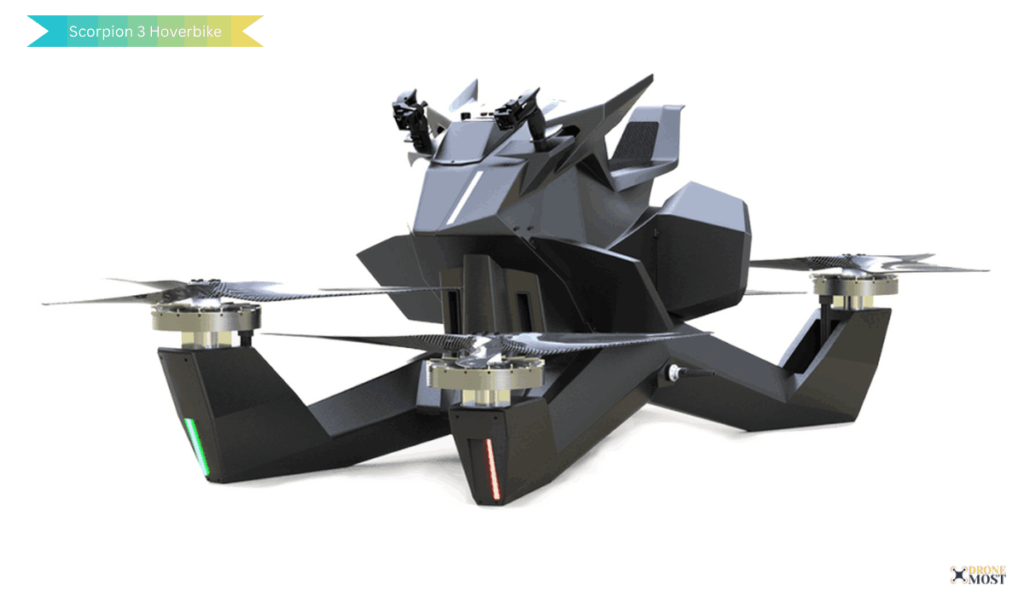
Key Features:
- Hybrid Propulsion: Combines an electric motor with a gasoline engine for extended range and efficiency.
- Vertical Takeoff and Landing (VTOL): Eliminates the need for runways, opening up possibilities for flexible takeoff and landing locations.
- Dual Joystick Control: Intuitive piloting system for manoeuvrability and control.
- Parachute System: Emergency safety feature for added peace of mind.
- Enclosed Cockpit: Weather protection and improved comfort for the pilot.
- Heads-Up Display (HUD): Provides critical flight information for safe and informed piloting.
Specifications:
- Maximum Speed: 80 km/h (50 mph)
- Range: Up to 25 km (15.5 miles)
- Flight Time: Approximately 15 minutes
- Payload Capacity: 100 kg (220 lbs)
- Dimensions: 3.35 x 2.6 x 1.1 meters (11 x 8.2 x 3.6 ft)
- Weight: 280 kg (617 lbs)
Pros:
- An exciting and novel form of personal transportation.
- Offers freedom and manoeuvrability unlike cars or traditional aircraft.
- Environmentally friendly with electric propulsion and zero emissions.
- Potentially cost-effective compared to other eVTOL options.
- Relatively compact and could be used in more locations compared to larger eVTOLs.
Cons:
- Still in the prototype stage, with safety and regulatory concerns to be addressed before widespread adoption.
- Limited range and flight time may not be suitable for long-distance travel.
- Requires pilot training and specific regulations might apply depending on region.
- Unclear pricing and availability, likely expensive initially.
- Public acceptance and potential noise concerns need to be considered.
AEE F100 (the most expensive drone in the world- $58,000)
The AEE F100, priced at $58,000, transcends the realm of ordinary drones, emerging as a military-grade marvel. Designed for defence and surveillance applications, this high-end UAV goes beyond the conventional, offering unparalleled security and tactical capabilities.
Its robust construction and cutting-edge features make it an indispensable asset in safeguarding critical areas. While the price may seem substantial,
It reflects the investment in advanced technologies that empower military and security forces with state-of-the-art aerial surveillance, solidifying the AEE F100’s position as a top-tier solution for defence-oriented applications.
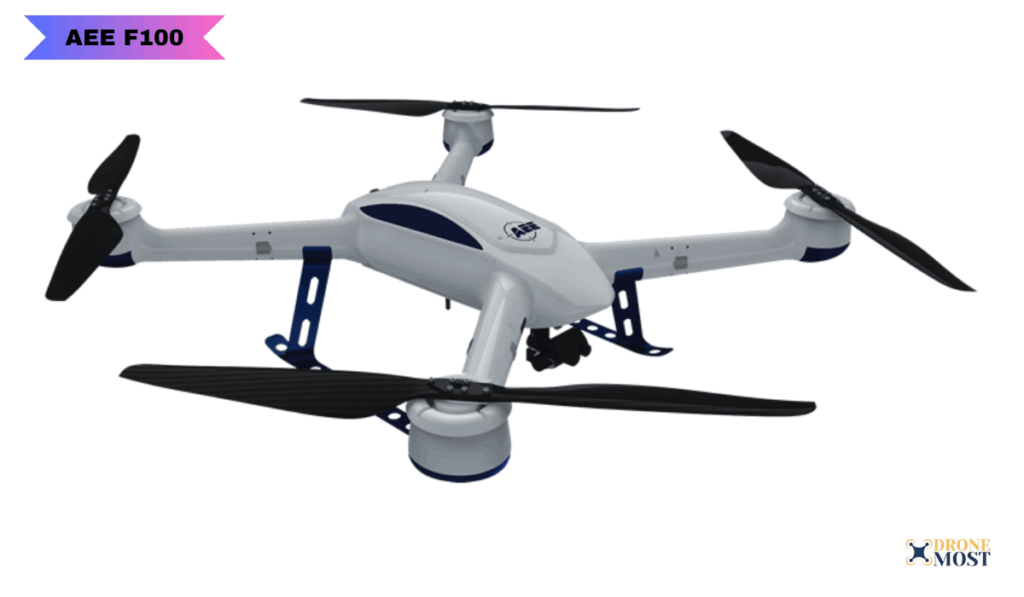
Key Features:
- Compact and Portable: Foldable design fits easily into a backpack, making it convenient for travel and outdoor adventures.
- 4K Camera: Captures high-resolution videos (3840 x 2160) and photos, offering exceptional image quality.
- 3-Axis Gimbal: Stabilizes the camera for smooth, cinematic footage, even in windy conditions.
- GPS and Intelligent Flight Modes: Features GPS-assisted flight functions like Follow Me, Orbit, and Altitude Hold for hands-free shots and easier navigation.
- Return to Home: Automatically returns to its takeoff point if it loses signal or battery power, enhancing safety.
Specifications:
- Weight: 540 grams (1.19 pounds)
- Size (folded): 175 x 100 x 65 mm
- Size (unfolded): 365 x 365 x 100 mm
- Camera: 14MP CMOS sensor with 4K video recording at 30fps
- Gimbal: 3-axis gimbal for stabilization
- Flight time: Up to 25 minutes (depending on conditions)
- Range: Up to 500 meters (1640 feet)
- Battery: 11.1V 2500mAh LiPo battery
- Controller: Included 2.4GHz remote controller
Pros:
- Portable and easy to transport.
- High-quality 4K camera for stunning aerial footage.
- Stable 3-axis gimbal for smooth videos.
- Intelligent flight modes for easier operation and creative shots.
- GPS-assisted features for safety and navigation.
Cons:
- Relatively short flight time compared to some larger drones.
- Limited range compared to high-end models.
- Not as powerful in windy conditions as larger drones.
- Camera quality may not match the best professional drones.
Buying Considerations for the Most Expensive Drones in the World
As drone technology continues to push the boundaries of innovation, the pursuit of the most advanced and expensive drones becomes a journey fueled by both passion and practicality. In this exploration, we unravel the key buying considerations for those who seek not just a flying machine, but a marvel of engineering and capability.
-
Advanced Flight Capabilities
In the realm of the most expensive drones, the skies are the limit when it comes to advanced flight capabilities. Seek drones that offer more than just basic manoeuvrability. Look for features like autonomous navigation, obstacle avoidance systems, and precise GPS functionality. These enhance the flying experience and ensure a safer and more controlled operation.
-
High-Resolution Camera Systems
For many enthusiasts and professionals, the allure of premium drones lies in their ability to capture breathtaking aerial footage. When considering the most expensive drones, prioritize those equipped with state-of-the-art 4K or higher resolution cameras. The clarity and detail offered by these cameras, coupled with features like gimbal stabilization and zoom capabilities, elevate the entire photography and videography experience.
-
Extended Battery Life
In the world of high-end drones, time in the air is a precious commodity. Look for drones that boast cutting-edge battery technology, providing a substantial flight time of at least 30 minutes or more. This extended battery life ensures that you can maximize your drone’s potential without the constant need for recharging, making it an ideal choice for professionals engaged in aerial photography or surveying.
-
Durability and Build Quality
Considering the significant investment involved, durability and build quality should be at the forefront of your buying considerations. The most expensive drones are crafted from high-quality materials, making them robust and capable of withstanding challenging weather conditions and accidental collisions. A sturdy build ensures longevity and reliability, crucial factors for those who demand the best.
FAQs (Frequently Asked Questions)
Why are the most expensive drones so costly?
The high cost of premium drones can be attributed to the cutting-edge technologies they incorporate. Advanced flight systems, top-tier camera capabilities, extended battery life, and robust build quality contribute to their elevated price tags. These features ensure an unparalleled user experience, making the investment worthwhile for enthusiasts and professionals.
Are these drones legal to fly everywhere?
While the legality of drone flight varies by location, most countries have regulations in place. It’s crucial to research and adhere to local drone laws, including restrictions on flying in certain areas and obtaining necessary permits. The advanced features of expensive drones often include geo-fencing to help users comply with these regulations.
Can beginners handle the complexity of high-end drones?
While high-end drones come with advanced features, many are designed with user-friendly interfaces and automated functions. Beginners can start with these models, gradually exploring the advanced capabilities as they gain experience. However, it’s recommended for novices to undergo basic drone training to ensure safe and responsible piloting.
Do these drones require special maintenance?
The most expensive drones are often built with durability in mind, requiring less maintenance than lower-end models. Regular checks on propellers, motors, and firmware updates are advisable. Manufacturers typically provide guidelines for proper care, ensuring longevity and optimal performance.
What kind of skills are necessary to operate high-end drones?
Operating high-end drones requires a basic understanding of drone piloting, including controls, safety measures, and flight regulations. Many premium models come with intelligent flight modes that automate certain processes, making them accessible to users with varying skill levels. However, to unlock the full potential of these drones, developing advanced piloting skills is recommended.
Conclusion
The world of expensive drones is not just about the price; it’s about the possibilities they unlock. As technology continues to evolve, so do the questions surrounding these aerial marvels. By demystifying common queries, we aim to empower enthusiasts and professionals to make informed decisions and fully enjoy the immersive experience that high-end drones offer.

